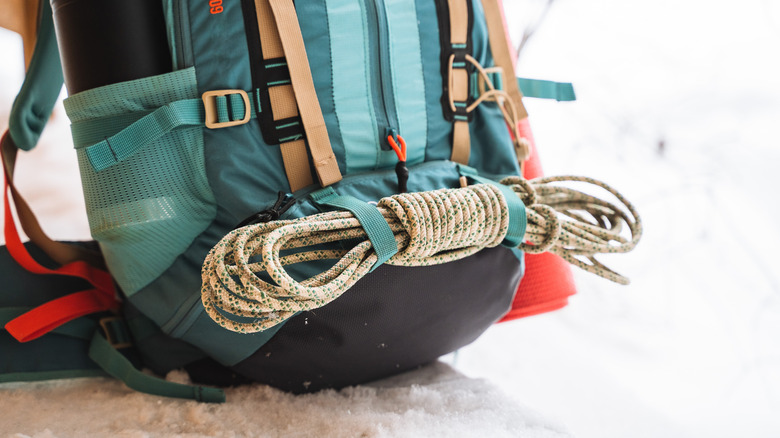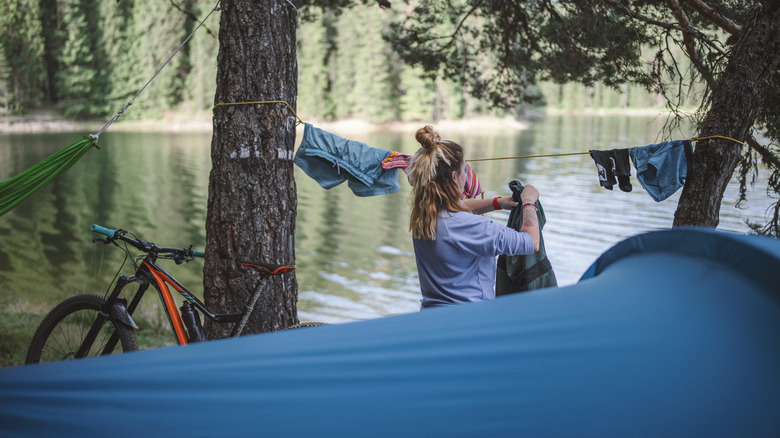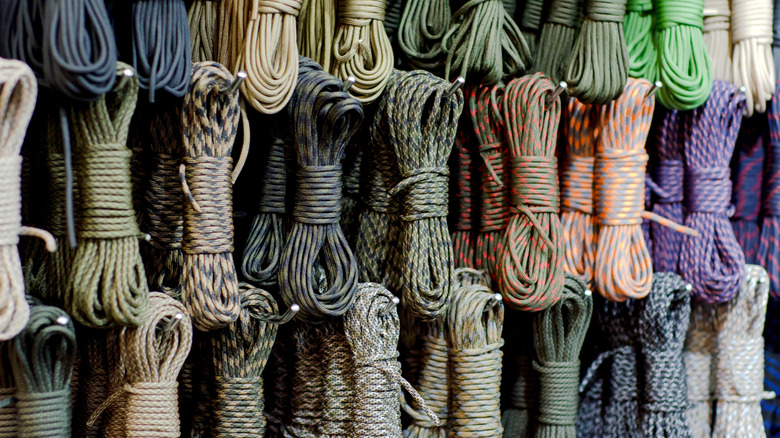Tie This Versatile Item To Your Backpack For Quick Access During Outdoor Adventures
Some outdoor tools are timeless. At some point, almost every backpacker will be glad to have brought a decent knife, and fire-starters, like matches and lighters, are the very objects that seem to distinguish us from other mammals. And there's no need to dive deep into the virtues of disposable tissue paper. For as long as these inventions have existed, hikers and campers have carried them along. Some we colloquially refer to as "total life savers," while others may literally save our lives.
So it is with a good old-fashioned rope. Just about every society on Earth has employed some kind of rope or cord, dating back to prehistory. The Inca people famously abstained from using wheels, but they built nearly indestructible bridges out of rope. Rope has helped humans dry laundry, climb mountains, and rescue people from ravines and quicksand. Untold thousands of sailboats are still rigged with rope, just as they have been for millennia. Rope really does bind humanity together.
This is why many hikers tie a rope to the outside of their backpacks, whether or not they have a specific purpose in mind. Many outdoors enthusiasts, especially newbies, never think to bring it, yet a length of synthetic rope — such as paracord — can come in handy in countless ways. You could easily add rope to any guide to the best and safest hiking gear.
The many uses of rope
For backpackers, the most obvious use of rope is at a campsite. Once you've washed your clothes, you can string up a drying line between two suspension points, most likely trees. When in bear country, some campers still stuff all their food into a sack and hoist it into the upper branches; the "bear bag" is a simple, lightweight alternative to the unwieldy bear vault, and it protects your sundries from other hungry animals as well. You can bundle items — including bunches of firewood — or tie items down during high winds. One of the classic techniques for tent camping is the "deadman" anchor, where campers tie their tent to a rock or log to keep it sturdy.
Those are all optional uses, yet lots of camp-related gear requires a rope to function. Most hammocks have to be tethered to trees, as do rain flies stretched over tents. You can use rope and a tarp to create an artificial roof during periods of rain or hail. Emergency shelters are often hung on "guylines" to keep them upright, although these are only really useful in wooded areas. Winter campers regularly strap on skis or snowshoes and pull their gear behind them on a sled; this kind of system is known as a "pulk," and it can be as simple as a rope tied between a sled and a belt.
With practice, you can use rope in more ambitious ways. Groups of hikers in the wilderness may ford a river by fixing a line on either bank; others can pull themselves over a crevasse with a so-called "Tyrolean traverse." Naturally, rock climbers and spelunkers use nylon ropes extensively to belay and rappel themselves safely.
Buying and carrying rope on the trail
Modern ropes come in all lengths and thicknesses. Paracord was originally developed for parachutes; it's lightweight, flexible, and remarkably strong, all helpful assets when you're on the trail. Paracord is almost always thin, so you can carry great lengths without taking much space. A classic technique is to wrap paracord around your backpack strap, then tie it off with a slipknot; this way, you can quickly pull the cord and unravel it without removing the backpack from your shoulders. Finally, paracord is almost comically inexpensive; you can buy hundreds of feet of the stuff for $10 or less.
For more sophisticated rope work — the kind of skills you would use for rock climbing or emergencies — paracord is too narrow and slick to rely on. The vast majority of climbers use nylon rope; when properly used and cared for, nylon is essentially unbreakable and has a forgiving elasticity. Alternative materials include hemp and cotton rope, which each have their pros and cons for use in the wild. Alpinists routinely fasten these ropes to the outside of their backpacks; because these ropes are almost always bulkier, they don't tie primly around a strap like paracord, but should be bundled and affixed to the main body of the backpack.
The one downside to carrying rope this way is its exposure to moisture. Pretty much all woven cords become stiff and difficult to manipulate when wet, regardless of material. This is one of the tips to consider when taking your climbing outdoors.


